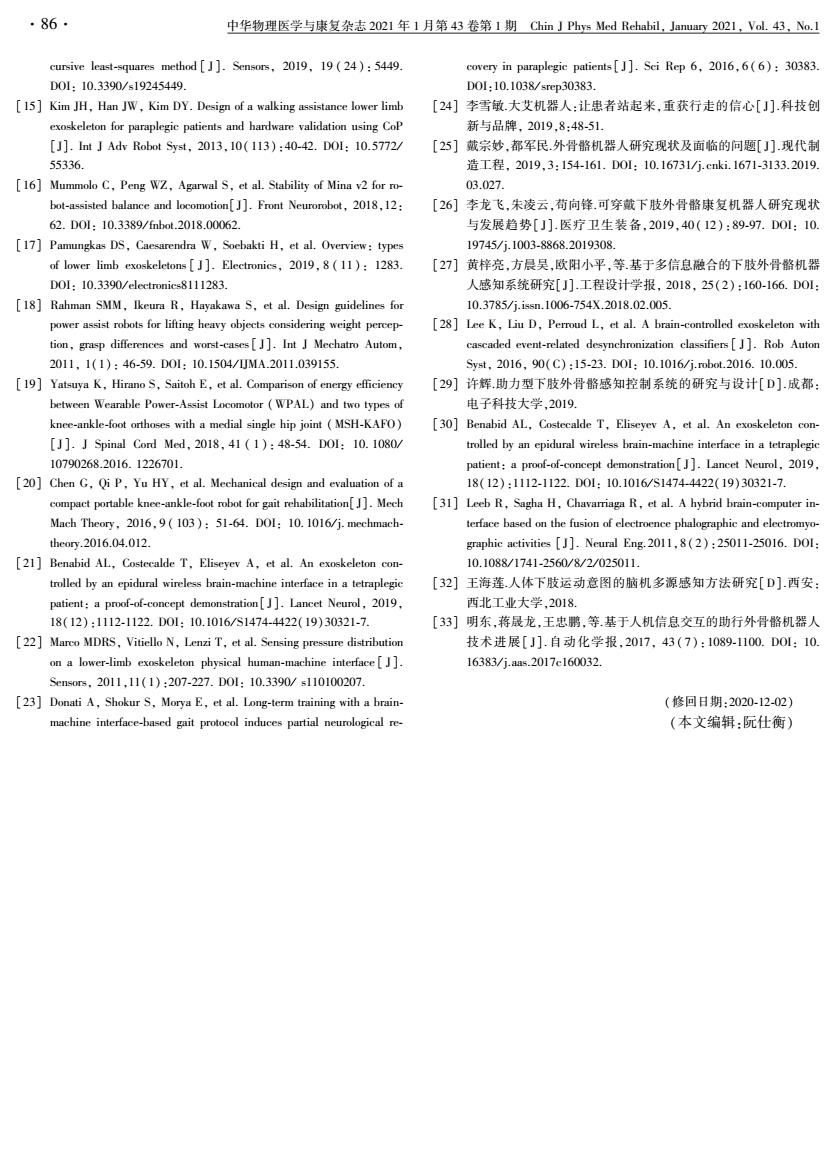正在加载图片...

·86· 中华物理医学与康复杂志2021年1月第43卷第1期Chin J Phys Med Rehabil,January202l,Vol.43,No.1 cursive least-squares method J].Sensors,2019.19(24):5449. covery in paraplegic patients[J].Sci Rep 6,2016,6(6):30383. D0I:10.3390/s19245449. D0l:10.1038/srep30383. [15]Kim JH,Han JW,Kim DY.Design of a walking assistance lower limb [24]李雪敏.大艾机器人:让患者站起来,重获行走的信心[J】科技创 exoskeleton for paraplegic patients and hardware validation using Cop 新与品牌,2019.8:48-51. [J].Int J Adv Robot Syst,2013,10(113):40-42.D0I:10.5772/ [25]戴宗妙,都军民.外骨骼机器人研究现状及面临的问题[J】.现代制 55336. 造工程,2019,3:154-161.D0:10.16731/j.cmki.1671-3133.2019. [16]Mummolo C,Peng WZ,Agarwal S,et al.Stability of Mina v2 for ro- 03.027. bot-assisted balance and locomotion[J].Front Neurorobot,2018,12: [26]李龙飞,朱凌云,苟向锋.可穿戴下肢外骨酪康复机器人研究现状 62.D0I:10.3389/fbot.2018.00062. 与发展趋势[J].医疗卫生装备,2019,40(12):89-97.D01:10. [17]Pamungkas DS,Caesarendra W.Soebakti H,et al.Overview:types 19745/j.1003-8868.2019308. of lower limb exoskeletons [J ]Electronics,2019,8(11):1283. [27]黄梓亮,方晨吴,欧阳小平,等.基于多信息融合的下肢外骨酪机器 D0I:10.3390/electronics8111283. 人感知系统研究[J】工程设计学报,2018,25(2):160-166.D01: [18]Rahman SMM,Ikeura R,Hayakawa S.et al.Design guidelines for 10.3785/j.issn.1006-754X.2018.02.005. power assist robots for lifting heavy objects considering weight percep- [28 Lee K,Liu D,Perroud L,et al.A brain-controlled exoskeleton with tion,grasp differences and worst-cases[].Int J Mechatro Autom, cascaded event-related desynchronization classifiers[].Rob Auton 2011,1(1):46-59.D0L:10.1504/MA.2011.039155. Syst,2016,90(C):15-23.D0I:10.1016/j.robt.2016.10.005. [19]Yatsuya K,Hirano S,Saitoh E,et al.Comparison of energy efficiency [29]许辉.助力型下肢外骨骼感知控制系统的研究与设计[D].成都: between Wearable Power-Assist Locomotor (WPAL)and two types of 电子科技大学,2019. knee-ankle-foot orthoses with a medial single hip joint (MSH-KAFO) [30]Benabid AL,Costecalde T,Eliseyev A,et al.An exoskeleton con- [J].J Spinal Cord Med,2018,41(1):48-54.D0I:10.1080/ trolled by an epidural wireless brain-machine interface in a tetraplegic 10790268.2016.1226701. patient:a proof-of-concept demonstration[J].Lancet Neurol,2019, [20]Chen G,Qi P.Yu HY,et al.Mechanical design and evaluation of a 18(12):1112-1122.D01:10.1016/S1474-4422(19)30321-7. compact portable knee-ankle-foot robot for gait rehabilitation[.Mech [31]Leeb R,Sagha H,Chavarriaga R.et al.A hybrid brain-computer in- Mach Theory,2016,9(103):51-64.DOI:10.1016/j.mechmach- terface based on the fusion of electroence phalographic and electromyo- theory.2016.04.012 graphie activities [J].Neural Eng.2011.8(2):25011-25016.DOI: [21]Benabid AL,Costecalde T,Eliseyev A,et al.An exoskeleton con- 10.1088/1741-2560/8/2/025011. trolled by an epidural wireless brain-machine interface in a tetraplegic [32]王海莲人体下肢运动意图的脑机多源感知方法研究[D]西安: patient:a proof-of-concept demonstration[J].Lancet Neurol,2019, 西北工业大学,2018. 18(12):1112-1122.D01:10.1016/S1474-4422(19)30321-7. [33]明东,蒋晟龙,王忠鹏,等.基于人机信息交互的助行外骨骼机器人 [22]Marco MDRS,Vitiello N,Lenzi T,et al.Sensing pressure distribution 技术进展[J].自动化学报,2017,43(7):1089-1100.D0I:10. on a lower-limb exoskeleton physical human-machine interface[J]. 16383/j.aas.2017c160032. Sensors,2011,11(1):207-227.D01:10.3390/s110100207. [23]Donati A,Shokur S,Morya E,et al.Long-term training with a brain- (修回日期:2020-12-02) machine interface-based gait protocol induces partial neurological re- (本文编辑:阮仕衡)cursive least ̄squares method [ J]. Sensorsꎬ 2019ꎬ 19 ( 24 ): 5449. DOI: 10.3390 / s19245449. [15] Kim JHꎬ Han JWꎬ Kim DY. Design of a walking assistance lower limb exoskeleton for paraplegic patients and hardware validation using CoP [J]. Int J Adv Robot Systꎬ 2013ꎬ10( 113):40 ̄42. DOI: 10.5772 / 55336. [16] Mummolo Cꎬ Peng WZꎬ Agarwal Sꎬ et al. Stability of Mina v2 for ro ̄ bot ̄assisted balance and locomotion[J]. Front Neurorobotꎬ 2018ꎬ12: 62. DOI: 10.3389 / fnbot.2018.00062. [17] Pamungkas DSꎬ Caesarendra Wꎬ Soebakti Hꎬ et al. Overview: types of lower limb exoskeletons [ J]. Electronicsꎬ 2019ꎬ 8 ( 11): 1283. DOI: 10.3390 / electronics8111283. [18] Rahman SMMꎬ Ikeura Rꎬ Hayakawa Sꎬ et al. Design guidelines for power assist robots for lifting heavy objects considering weight percep ̄ tionꎬ grasp differences and worst ̄cases [ J]. Int J Mechatro Automꎬ 2011ꎬ 1(1): 46 ̄59. DOI: 10.1504 / IJMA.2011.039155. [19] Yatsuya Kꎬ Hirano Sꎬ Saitoh Eꎬ et al. Comparison of energy efficiency between Wearable Power ̄Assist Locomotor (WPAL) and two types of knee ̄ankle ̄foot orthoses with a medial single hip joint (MSH ̄KAFO) [J ]. J Spinal Cord Medꎬ 2018ꎬ 41 ( 1 ): 48 ̄54. DOI: 10. 1080 / 10790268.2016. 1226701. [20] Chen Gꎬ Qi Pꎬ Yu HYꎬ et al. Mechanical design and evaluation of a compact portable knee ̄ankle ̄foot robot for gait rehabilitation[J]. Mech Mach Theoryꎬ 2016ꎬ9 ( 103): 51 ̄64. DOI: 10. 1016 / j. mechmach ̄ theory.2016.04.012. [21] Benabid ALꎬ Costecalde Tꎬ Eliseyev Aꎬ et al. An exoskeleton con ̄ trolled by an epidural wireless brain ̄machine interface in a tetraplegic patient: a proof ̄of ̄concept demonstration[ J]. Lancet Neurolꎬ 2019ꎬ 18(12):1112 ̄1122. DOI: 10.1016 / S1474 ̄4422(19)30321 ̄7. [ 22] Marco MDRSꎬ Vitiello Nꎬ Lenzi Tꎬ et al. Sensing pressure distribution on a lower ̄limb exoskeleton physical human ̄machine interface [ J]. Sensorsꎬ 2011ꎬ11(1):207 ̄227. DOI: 10.3390 / s110100207. [23] Donati Aꎬ Shokur Sꎬ Morya Eꎬ et al. Long ̄term training with a brain ̄ machine interface ̄based gait protocol induces partial neurological re ̄ covery in paraplegic patients[ J]. Sci Rep 6ꎬ 2016ꎬ6 ( 6): 30383. DOI:10.1038 / srep30383. [24] 李雪敏.大艾机器人:让患者站起来ꎬ重获行走的信心[ J].科技创 新与品牌ꎬ 2019ꎬ8:48 ̄51. [25] 戴宗妙ꎬ都军民.外骨骼机器人研究现状及面临的问题[ J].现代制 造工程ꎬ 2019ꎬ3:154 ̄161. DOI: 10.16731 / j. cnki.1671 ̄3133.2019. 03.027. [26] 李龙飞ꎬ朱凌云ꎬ苟向锋.可穿戴下肢外骨骼康复机器人研究现状 与发展趋势[ J].医疗卫生装备ꎬ2019ꎬ40 ( 12):89 ̄97. DOI: 10. 19745 / j.1003 ̄8868.2019308. [27] 黄梓亮ꎬ方晨昊ꎬ欧阳小平ꎬ等.基于多信息融合的下肢外骨骼机器 人感知系统研究[J].工程设计学报ꎬ 2018ꎬ 25(2):160 ̄166. DOI: 10.3785 / j.issn.1006 ̄754X.2018.02.005. [28] Lee Kꎬ Liu Dꎬ Perroud Lꎬ et al. A brain ̄controlled exoskeleton with cascaded event ̄related desynchronization classifiers [ J]. Rob Auton Systꎬ 2016ꎬ 90(C):15 ̄23. DOI: 10.1016 / j.robot.2016. 10.005. [29] 许辉.助力型下肢外骨骼感知控制系统的研究与设计[D].成都: 电子科技大学ꎬ2019. [30] Benabid ALꎬ Costecalde Tꎬ Eliseyev Aꎬ et al. An exoskeleton con ̄ trolled by an epidural wireless brain ̄machine interface in a tetraplegic patient: a proof ̄of ̄concept demonstration[ J]. Lancet Neurolꎬ 2019ꎬ 18(12):1112 ̄1122. DOI: 10.1016 / S1474 ̄4422(19)30321 ̄7. [31] Leeb Rꎬ Sagha Hꎬ Chavarriaga Rꎬ et al. A hybrid brain ̄computer in ̄ terface based on the fusion of electroence phalographic and electromyo ̄ graphic activities [ J]. Neural Eng.2011ꎬ8( 2):25011 ̄25016. DOI: 10.1088 / 1741 ̄2560 / 8 / 2 / 025011. [32] 王海莲.人体下肢运动意图的脑机多源感知方法研究[D].西安: 西北工业大学ꎬ2018. [33] 明东ꎬ蒋晟龙ꎬ王忠鹏ꎬ等.基于人机信息交互的助行外骨骼机器人 技术进展[ J]. 自动化学报ꎬ2017ꎬ 43 ( 7):1089 ̄1100. DOI: 10. 16383 / j.aas.2017c160032. (修回日期:2020 ̄12 ̄02) (本文编辑:阮仕衡) 86 中华物理医学与康复杂志 2021 年 1 月第 43 卷第 1 期 Chin J Phys Med Rehabilꎬ January 2021ꎬ Vol. 43ꎬ No.1